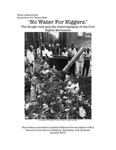"No Water for Niggers": The Hough Riots and the Historiography of the Civil Rights Movement
Editorial: MSL Academic Endeavors
Licencia: Creative Commons (by)
Autor(es): Olivia Lapeyrolerie
The summer of 1966 was abnormally hot for Cleveland, Ohio. The average
temperature in July was twenty-seven degrees Celsius, and there had been eighteen
consecutive days of zero precipitation.1 Mirroring the temperatures outside, the tensions
inside the Seventy-Niner’s Café were running high on 18 July. Owned by Jewish
brothers, Dave and Abe Feigenbaum, the Seventy-Niner’s Café was located at the corner
of Hough Avenue and 79th Street in the Hough neighborhood. Stretching from East 55th
to 105th between Superior and Euclid Avenues, Hough was only two square miles. The
Seventy-Niner’s Café was not only the geographical center of the predominately, black
neighborhood but also the center of the riots that would ravage the poorest, most
overcrowded section of the city from 18 July until 23 July 23, 1966. 2
While the relationship between local blacks and whites in Hough had been
strained for a long time, it had not reached such violent proportions until the summer of
1966. At the end of June, there had been skirmishes between members of the majority
white Cleveland Police Department and young, black teenagers in the adjacent
neighborhood. On the evening of 18 July, an African-American man walked into the
Seventy-Niner’s Café and ordered a bottle of wine to go and a cup of ice water. The
Feigenbaums later told reporters that this black man was like all the other cheap,
alcoholic denizens of their bar who tried to violate the Ohio law which prohibited carryout wine to be consumed on the premises of the café: ‘The wine-heads dump the water
and pour the wine into the glass. It’s cheaper than buying a straight glass of wine.’ 3
Enraged by the Feigenbaum’s poor treatment, the black customer left and posted a sign
outside the bar that said, ‘No Water for Niggers.’4 Rumors of the sign quickly spread
throughout the neighborhood, and a large crowd began to congregate outside the bar. The
crowd became increasingly agitated as the night wore on, and the Feigenbaums decided
to call the police. The police arrived after some delay yet failed to disperse the crowd.
Compartir:
Una vez que el usuario haya visto al menos un documento, este fragmento será visible.


